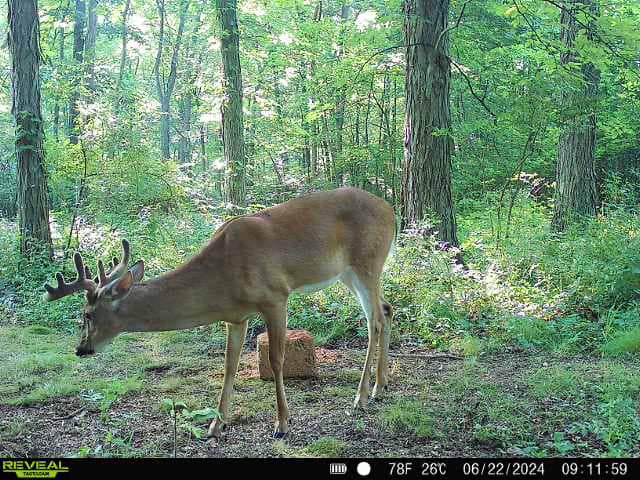
Whitetail Deer Antler Development
It's late June, and we are now working on getting trail cameras set up. This is one of our favorite times of the year. With the help of cellular cameras, we can see the trophy bucks on our farms develop over the summer before our eyes. Sometimes, it makes us feel like a kid opening up a gift at Christmas. It's an exciting time for us because we get to see what is emerging this year for our Ohio deer hunters. We get to see the fruit of all the hard work and quality deer management from the previous year.
We hunters are fascinated by the uniqueness and beauty of the whitetail buck. This is the time of year when each buck's characteristics and identity emerge. These whitetail deer are indeed renowned for their majestic antlers, a symbol of strength and beauty. These antlers aren’t just something that we hunters find intriguing; they play a vital role in mating rituals, dominance displays, and even survival strategies. Unraveling the mysteries behind the development of whitetail deer antlers will not only deepen our understanding of these amazing creatures but also shed light on the intricate processes that occur in the natural world. In this article, we will explore the unique journey of antler development in whitetail deer, from the growth cycle and factors influencing their size to the fascinating regenerative abilities they possess.

Book Your Ohio Deer Hunt:
Email or Call us today at 419-543-3433
The Growth Cycle of Whitetail Deer Antlers:
Like many members of the deer family, whitetail deer experience an annual cycle of antler growth and shedding. It begins shortly after the previous year's antlers are shed. Nutritional factors, such as the availability of food resources, play a crucial role in initiating the growth phase. During this time, blood vessels called antlerogenic periosteal vessels (APV) begin to form. The antlers will continue to grow throughout the summer months, fuelled by the deer's increasing intake of nutrients. Antlers usually grow up to a 1/4 inch per day, but can sometimes grow as fast as a 1/2 inch per day! By late summer, the antlers have reached their maximum potential size.
Factors Influencing Antler Size:
Several factors impact the size and quality of whitetail deer antlers. Genetics is one of the primary contributors, as each individual deer has a unique set of genes that influence antler development. However, other external factors also come into play. Diet, age, and overall body health all play essential roles in determining antler size. Nutritional intake, especially protein, is crucial during the antler's growth phase. Deer with access to a diverse range of food sources are more likely to develop larger antlers. Additionally, younger bucks generally have smaller antlers than older ones, as antler size tends to increase with age.

Regeneration and Casting of Antlers:
The process of antler development is truly remarkable but equally fascinating is the regeneration and shedding of these majestic appendages. After the antlers have reached their full size, hormones begin to signal the onset of the breeding season. Following mating, testosterone levels drop, ultimately leading to the casting or shedding of the antlers. The casting process usually occurs in early winter, triggered by the weakening of the tissue attaching the antlers to the deer's skull. Once the antlers are shed, fresh blood flow is restricted to the stump, and a thin layer of skin known as velvet covers the growing antlers underneath. This velvet-encased regeneration process is driven by an intricate network of blood vessels and lasts until spring when the cycle restarts.
Evolutionary Significance and Adaptive Benefits:
The development of antlers in whitetail deer serves numerous evolutionary purposes, primarily related to reproduction and survival. In the animal kingdom, antlers serve as symbols of dominance, allowing dominant males to establish their territory and secure mating opportunities. Size, form, and symmetry of antlers all play a role in attracting mates and deterring potential rivals. Furthermore, antlers serve as formidable weapons during aggressive encounters. Their structural strength and complex design enable bucks to engage in combat, reducing the risk of physical harm and increasing their chances of survival.
Conservation and Management Considerations:
Whitetail deer hunting and management programs often involve consideration of antler development. Careful monitoring of antler size and age-class distribution can provide essential insights into the overall health and population dynamics of deer herds. By managing harvest quotas and implementing measures to improve nutrition and habitat quality, wildlife conservationists can create conditions that promote healthier deer populations with robust antler development. Here at Rut Chasers, LLC, we take careful consideration of deer management and restrict antler size so that our young, promising bucks can grow to the massive antlered bucks that our hunters are after. The old saying “Let them go and let them grow” (which means low pressure and imposing antler restrictions) is the main reason we have such great hunting opportunities for trophy whitetail deer here in Ohio.
Conclusion:
Whitetail deer antler development is a fascinating and multi-faceted process that plays a vital role in the survival, reproduction, and overall well-being of these magnificent creatures. From the growth cycle, influenced by nutritional factors and genetics, to the remarkable regenerative abilities and adaptive benefits of antlers, the journey of antler development invites us into the natural world's intricate mechanisms. Understanding these processes not only deepens our appreciation for whitetail deer but also highlights the importance of conservation efforts to sustain their populations and ensure the preservation of this spectacular phenomenon for generations to come. If you’re ready to encounter trophy whitetail deer hunting at its finest, contact Rut Chasers, LLC today. We are a hunting outfitter in Ohio that can put you on the trophy whitetail deer of your dreams!

Book Your Ohio Deer Hunt:
Email or Call us today at 419-543-3433
 Prev Post
Prev Post

















